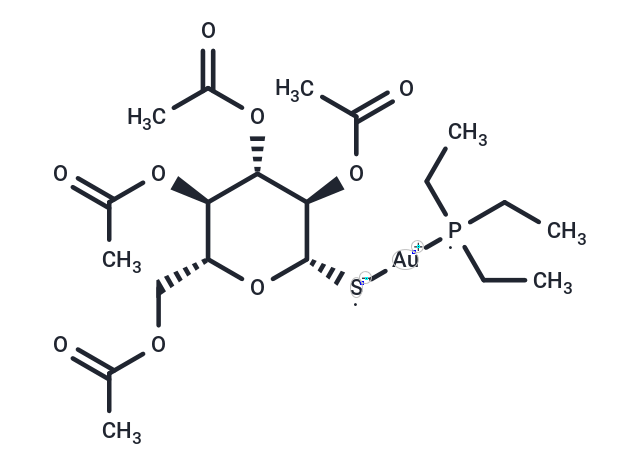Shopping Cart
Remove All Your shopping cart is currently empty
Your shopping cart is currently empty
Auranofin (SKF-39162) is an antirheumatic agent, is used to treat rheumatoid arthritis, improves arthritis symptoms including painful or tender and swollen joints and morning stiffness.

| Pack Size | Price | USA Warehouse | Global Warehouse | Quantity |
|---|---|---|---|---|
| 5 mg | $35 | In Stock | In Stock | |
| 10 mg | $56 | In Stock | In Stock | |
| 25 mg | $107 | In Stock | In Stock | |
| 50 mg | $180 | In Stock | In Stock | |
| 100 mg | $275 | In Stock | In Stock | |
| 200 mg | $397 | In Stock | In Stock | |
| 1 mL x 10 mM (in DMSO) | $61 | In Stock | In Stock |
| Description | Auranofin (SKF-39162) is an antirheumatic agent, is used to treat rheumatoid arthritis, improves arthritis symptoms including painful or tender and swollen joints and morning stiffness. |
| Targets&IC50 | NCI-H1299 cells:1 µM, TrxR:0.2 μM, SK-LU-1 cells:5 µM, Calu-6 cells:3 µM, HPF cells:3 µM, A549 cells:5 µM, NCI-H4 cells60 cells:4 µM |
| In vitro | Auranofin, an established rheumatoid arthritis treatment, also shows promise across a spectrum of other conditions such as cancer and neurodegenerative diseases. It triggers apoptosis via a Bax/Bak-dependent pathway by selectively disrupting mitochondrial redox balance and oxidizing Prx3[1]. Furthermore, auranofin hampers SKOV3 cell proliferation and survival in a dose- and time-specific manner, instigating caspase-3 activation, elevating pro-apoptotic Bax and Bim proteins, and diminishing the anti-apoptotic Bcl-2 in SKOV3 cells[2]. This lipophilic gold-based agent, known for its anti-inflammatory and immunosuppressive characteristics, notably impedes cell growth and induces mitochondrial apoptosis in PC3 human prostate cancer cells, with a noteworthy reduction in cell viability at an IC50 of 2.5 µM after 24 hours[3]. |
| In vivo | Prophylactic treatment of adjuvant-induced arthritis rats with auranofin results in a slight reduction in paw edema, a complete normalization of the depressed IL-2 production, and a reduction of the elevated IL-1 production, without effect on the depressed IL-3 production[4]. |
| Cell Research | Auranofin is dissolved in DMSO. Cells are treated with auranofin (0, 50, 100, 200 and 400 nM) for 72 h for the dose-dependent response assay and 100 nM of auranofin is added into the wells for 0, 24, 72 and 120 h for the time-dependent response assay. Control cultures are treated with DMSO. Cell viability is measured by the MTT assay[2]. |
| Synonyms | SKF-39162 |
| Molecular Weight | 678.49 |
| Formula | C20H34AuO9PS |
| Cas No. | 34031-32-8 |
| Smiles | O(C(C)=O)[C@@H]1[C@@H](OC(C)=O)[C@H]([S-][Au+][P](CC)(CC)CC)O[C@H](COC(C)=O)[C@H]1OC(C)=O |
| Relative Density. | no data available |
| Storage | Powder: -20°C for 3 years | In solvent: -80°C for 1 year | Shipping with blue ice/Shipping at ambient temperature. | |||||||||||||||||||||||||||||||||||
| Solubility Information | DMSO: 252.5 mg/mL (372.15 mM), Sonication is recommended. | |||||||||||||||||||||||||||||||||||
| In Vivo Formulation | 10% DMSO+40% PEG300+5% Tween 80+45% Saline: 2.25 mg/mL (3.32 mM), Solution. Please add the solvents sequentially, clarifying the solution as much as possible before adding the next one. Dissolve by heating and/or sonication if necessary. Working solution is recommended to be prepared and used immediately. The formulation provided above is for reference purposes only. In vivo formulations may vary and should be modified based on specific experimental conditions. | |||||||||||||||||||||||||||||||||||
Solution Preparation Table | ||||||||||||||||||||||||||||||||||||
DMSO
| ||||||||||||||||||||||||||||||||||||
| Size | Quantity | Unit Price | Amount | Operation |
|---|

Copyright © 2015-2025 TargetMol Chemicals Inc. All Rights Reserved.